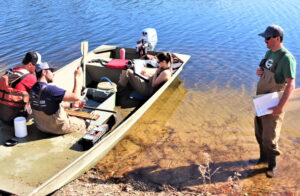CEMML directs environmental planning that meets military training objectives, complies with federal regulatory requirements, and protects natural and cultural resources.
Environmental Planning Services
- Preparation and updating of integrated Natural Resources Management Plans (INRMPs) and Integrated Cultural Resources Management Plans (ICRMPs)
- Develop new INRMPs/ICRMPs, including carrying out required surveys.
- Format INRMPs/ICRMPs to comply with DoD Branch standards.
- Conduct analysis to complete annual updates and five-year revisions.
- Assist with developing goals, objectives, and projects (GOPs).
- Development of National Environmental Policy Act (NEPA) analyses and documents, including environmental assessments and environmental impact statements.
- Management plans for fish and wildlife, forestry, and wildland fire; biological assessments; and policy reviews and analyses.
Latest CEMML Stories

Sharing the beach: CEMML supports snowy plovers and communities in California
In 2020, Vandenberg Space Force Station and CEMML began providing educational programs at local elementary schools to spread awareness about the snowy plover, a rare migratory shorebird currently listed as threatened under the federal Endangered Species Act. Over 600 students have participated in the program since the program began.

CEMML conducts surveys to aid fisheries management at Fort McCoy
Every year, watershed management biologists and specialists with CEMML, in partnership with Fort McCoy’s Directorate of Public Works Environmental Division Natural Resources Branch (NRB), hold fish surveys at Fort McCoy’s 10 lakes and ponds. Surveys are conducted using various methods to understand fish populations and the overall health of the waterways.

CEMML archaeological survey explores early 20th century history of Fort McCoy
An archaeological survey conducted by CEMML personnel in the summer of 2022 was initially meant to investigate the creation of several hundred concrete tent pads at Fort McCoy, Wisconsin. Research into the tent pads, dating from around the early 20th century, also unearthed additional information about other possible known archaeological features and sites around what is referred to as “Old Camp McCoy.”